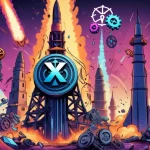Kaspa’s Smart Contract Launch on Kasplex: Innovation or Another Altcoin Flop?

Kaspa’s Smart Contract Launch: Breakthrough or Bust?
Kaspa (KAS) has just unleashed smart contracts through its Kasplex Layer-2 solution, a move that could elevate this underdog altcoin into the big leagues of decentralized apps (dApps) and DeFi. But with the price snoozing in a tight range, is this a hidden gem or another overhyped promise in the crowded crypto space?
- Tech Upgrade: Kaspa rolls out smart contracts with EVM compatibility, ZK rollups, and KRC-20 token support via Kasplex Layer-2.
- Price Limbo: KAS trades between $0.076 and $0.082, with resistance at $0.085–$0.090 showing no post-launch spark.
- Market Skepticism: Increased shorts and flat open interest suggest traders aren’t sold on the hype yet.
What’s New with Kasplex Layer-2?
Kaspa’s latest upgrade is a serious play to join the smart contract race, a must-have feature for any blockchain eyeing relevance in today’s dApp and DeFi-dominated landscape. Through Kasplex, a Layer-2 scaling solution, Kaspa now supports Ethereum Virtual Machine (EVM) compatibility. For the uninitiated, this means developers who’ve built on Ethereum—think of it as the Android of blockchain platforms—can easily port their projects or start fresh on Kaspa without learning a whole new coding language. It’s a massive barrier-breaker, opening the door to a flood of potential innovation.
But there’s more under the hood. Kasplex introduces zero-knowledge (ZK) rollups, a fancy way of bundling thousands of transactions into one tiny “summary” on the main chain. Imagine mailing a huge stack of letters by summarizing them into a single postcard—it cuts costs and speeds things up without losing the message. This scalability boost tackles one of blockchain’s biggest headaches: handling high volume without choking on fees or sacrificing security. Add to that support for KRC-20 tokens—Kaspa’s equivalent to Ethereum’s ERC-20 standard, which powers stablecoins and project tokens—and native microtransactions for dirt-cheap, instant payments, and you’ve got a platform that’s at least theoretically ready for prime time.
Kaspa’s core Layer-1 already stood out with its blockDAG (Directed Acyclic Graph) structure, a twist on traditional blockchains. Unlike Bitcoin or Ethereum, where blocks line up single-file, blockDAG processes multiple blocks in parallel, slashing confirmation times and boosting throughput. While exact transactions-per-second stats post-upgrade are still trickling in, early reports suggest Kaspa was handling over 10 TPS before Kasplex—respectable, though not Solana-level insane. Layer-2 aims to push this further by offloading heavy lifting from the main chain. It’s like Kaspa built a high-speed expressway on top of a solid highway—great engineering, but will drivers actually use it?
Market Reaction: Why the Yawn?
While the tech sounds slick, the market’s response has been a collective shrug. Kaspa’s price, pegged to the KAS/USDT pair, is stuck between $0.077 and $0.078, with a critical support floor at $0.076. Dip below that, and we’re looking at a potential slide to $0.073 or even $0.070—a bitter pill for anyone hoping for a launch-driven rally. On the upside, resistance looms at $0.082, with a tougher barrier between $0.085 and $0.090. Breaking through could eye a target of $0.10 to $0.105, but it’ll need a herd of bulls to charge in with real volume. For more insights on potential price movements, check out this analysis on Kaspa’s price outlook following the smart contract launch.
Rewind a bit: Kaspa bottomed out at $0.0727 in early September, clawing back with choppy rebounds but forming lower highs since mid-August. It’s a snooze-fest chart pattern—consolidation with no breakout in sight. Technical indicators aren’t screaming either. The Relative Strength Index (RSI) on the 4-hour timeframe hovers between the high-40s and mid-50s. Think of RSI as a market mood meter: above 70 signals over-excitement (often a sell cue), below 30 hints at gloom (a buy signal). Kaspa’s middle-of-the-road reading means neither side—bulls nor bears—has the wheel right now.
Trader sentiment leans cautious, bordering on bearish. Net shorts have crept up through September, showing more folks are betting on a drop, while net longs are flat or fading. Open interest delta—the flow of new money into futures contracts—is barely a blip, pointing to low leverage and a “wait and see” vibe. Compare this to past altcoin upgrades like Solana’s early scaling leaps or Avalanche’s subnet launches, where initial price pops often faded without sustained usage. Kaspa’s muted reaction isn’t unique; markets are littered with “buy the rumor, sell the news” traps. Without Bitcoin leading a broader rally, altcoins like KAS often struggle to find their footing post-hype.
Adoption Challenges and Opportunities
Let’s get real—Kaspa’s wading into a bloodbath of altcoin competition, and shiny tech alone won’t cut it. Ethereum remains the 800-pound gorilla of dApps and DeFi, with over $60 billion in total value locked (TVL) and a first-mover grip on developers. Solana, meanwhile, boasts lightning-fast transactions and a thriving NFT ecosystem, often processing trades for pennies in seconds. Kaspa’s pitch of high throughput and now smart contracts via Kasplex is intriguing, but it’s a David vs. Goliath showdown. What’s its edge? Microtransactions could be a niche—think tipping content creators or remittances in underbanked regions for fractions of a cent. If Kaspa nails that use case, it could carve out a loyal base.
Success boils down to adoption, plain and simple. Will developers flock to Kasplex? Watch for spikes in GitHub activity around Kaspa’s repos or early KRC-20 token launches—those are telltale signs of interest. On-chain metrics like transaction volume (trackable via explorers like Kaspa’s official dashboard) and wallet growth will reveal if users care. Picture this: a breakout DeFi app—say, a yield farm or micro-lending platform—chooses Kaspa for its low fees and speed. That’s the kind of catalyst that could shove KAS past $0.10. Without it, we’re looking at a ghost town, no matter how slick the Layer-2 tech is.
The flip side is brutal. History shows most altcoins fizzle without community or killer apps—think of the graveyard of 2017 ICOs. Kaspa’s been around since 2021, gaining some traction for its blockDAG innovation, but it’s still a minnow. Marketing matters too; if no one knows about Kasplex, devs won’t bother. And let’s not forget network effects—Ethereum’s ecosystem thrives because everyone’s already there. Kaspa needs to lure builders with incentives or partnerships, stat, or risk being just another “could’ve been” in crypto lore.
Risks and Broader Context
Beyond adoption hurdles, external risks loom. Altcoins with DeFi capabilities increasingly catch regulators’ eyes—look at the SEC’s crackdowns on tokens deemed unregistered securities. Kaspa isn’t yet a household name, but scaling up dApp activity could paint a target on its back. Security’s another concern; Layer-2 solutions, especially new ones, are juicy targets for hacks. Cross-chain bridge exploits have drained billions from other ecosystems—Kasplex better have ironclad audits, or early users could get burned.
Zooming out, Kaspa fits into the bigger fight for decentralization and financial freedom, a cause worth championing. Its potential for microtransactions aligns with disrupting bloated legacy systems—think sending money across borders without banks skimming 10% off the top. As a Bitcoin maximalist at heart, I see BTC as the ultimate hard money, a censorship-resistant store of value no altcoin can touch. But Kaspa’s programmable money and scalability experiments fill gaps Bitcoin shouldn’t chase. This diversity—Bitcoin as the bedrock, altcoins as the playground—is what fuels our revolution against centralized control. Still, I’m not blind to the odds; most altcoins fail, and Kaspa’s no guaranteed winner.
Key Takeaways and Questions
- Why is Kaspa’s smart contract launch significant?
It positions Kaspa as a contender for dApps and DeFi, with EVM compatibility easing the transition for Ethereum developers and ZK rollups boosting scalability. - Why isn’t Kaspa’s price moving post-upgrade?
The market’s skeptical, with KAS trapped between $0.076 and $0.082, reflecting a lack of immediate adoption proof and cautious trader sentiment. - What could drive Kaspa’s price higher?
Real developer uptake, a surge in KRC-20 tokens, or a standout DeFi app on Kasplex could push KAS toward $0.10–$0.105 with enough momentum. - What are the downside risks for Kaspa?
If adoption stalls or external pressures like regulation hit, KAS could drop to $0.070 or lower, especially amid broader altcoin weakness. - How does Kaspa fit into the crypto landscape?
It’s a long-shot scalability play complementing Bitcoin’s hard-money role, but faces stiff competition from Ethereum and Solana without standout community or apps.
Kaspa’s smart contract launch via Kasplex Layer-2 marks a bold step, no question. The tech checks out, the price sleeps, and the market’s giving it the cold shoulder for now. For crypto enthusiasts, this is a project to keep tabs on, especially if you’re into altcoins tinkering at the edges of blockchain’s potential. But history’s clear—most contenders don’t make it without a rabid community or game-changing use case. What’ll it take for Kaspa to defy the odds? Killer apps, savvy marketing, or just blind luck in a bull run? Keep an eye on those on-chain signals, tune out the moonboy noise, and let’s see if this altcoin can turn code into clout.



